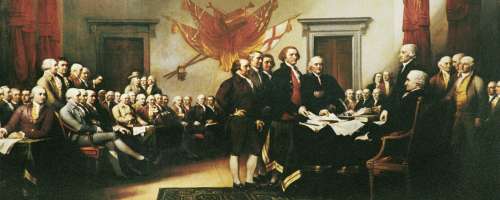 |
Patriot Resource Index
 American Revolution Index
American Revolution Index
 Surveys and Lists
Surveys and Lists
Military Campaigns
Reference Lists
Surveys By Year
-:1763-68: Tensions Rise
-:1768-74: Prelude to War
-:1775: War Begins
-:1776: Independence
-:1777: War Continues
-:1778: War Continues
-:1779: War Continues
-:1780: War Moves South
-:1781: Victory
Timeline: 1781
Battles: 1775-1781
-:1782-1789/Bibliography
 American Revolution Index
American Revolution Index
 Battles
Battles
 Documents
Documents
 Events
Events
 Landmarks & Places
Landmarks & Places
 People: The Patriots
People: The Patriots
 People: Continental Army
People: Continental Army
 People: British Army
People: British Army
 Timelines
Timelines
 Books
Books
 Multimedia
Multimedia
 Links & Other Resources
Links & Other Resources
Search the Site
Site Map
Contact Us
PatriotResource.com:
Main Index
Film Index
Film: Gladiator
Film: National Treasure
Film: The Patriot
Film: Tombstone
Films: General
Films: Fantasy
Films: SciFi
History: 1775-1781
History: September 11th
Lord of the Rings
NORAM Road Trips
OtherWorld: Index
TV Series: Index
TV: Battlestar Galactica
TV: Caprica
TV: Deadliest Catch
TV: Lost
TV Series: Action
TV Series: Animated
TV: BBC Presentations
TV Series: Comedy
TV Series: Drama
TV: Fantasy/SciFi
TV Series: Western
TV Series: Reviews
Military Campaigns
Reference Lists
Surveys By Year
-:1763-68: Tensions Rise
-:1768-74: Prelude to War
-:1775: War Begins
-:1776: Independence
-:1777: War Continues
-:1778: War Continues
-:1779: War Continues
-:1780: War Moves South
-:1781: Victory
Timeline: 1781
Battles: 1775-1781
-:1782-1789/Bibliography
Site Map
Contact Us
Main Index
Film Index
Film: Gladiator
Film: National Treasure
Film: The Patriot
Film: Tombstone
Films: General
Films: Fantasy
Films: SciFi
History: 1775-1781
History: September 11th
Lord of the Rings
NORAM Road Trips
OtherWorld: Index
TV Series: Index
TV: Battlestar Galactica
TV: Caprica
TV: Deadliest Catch
TV: Lost
TV Series: Action
TV Series: Animated
TV: BBC Presentations
TV Series: Comedy
TV Series: Drama
TV: Fantasy/SciFi
TV Series: Western
TV Series: Reviews

In the South, Lt. General Charles Cornwallis sent Lt. Colonel Banastre Tarleton after Brig. General Daniel Morgan. Tarleton caught up with Morgan on January 17, 1781. Morgan thoroughly defeated Tarleton at the Battle of Cowpens, South Carolina and then joined Maj. General Nathanael Greene for a retreat to Virginia from Cornwallis' main force. Morgan himself retired to his home in February due to illness.
During the ensuing 'Race to the Dan', General Cornwallis burned his wagons and overextended his force, while General Greene escaped by crossing the swollen Dan River into Virginia on February 13. On March 1, 1781, Greene crossed back into North Carolina and began manuevering against Cornwallis. On March 15, the two armies met at the Battle of Guilford Courthouse, North Carolina. Cornwallis held the field, but had received greater casualties than Greene. As a result, he abandoned the Carolinas and marched for Virginia.
In May 1781, Louisiana's Spanish Governor, Don Bernardo de Gálvez, concluded his successful campaign in West Florida when he captured Fort George in Pensacola. General Washington came out of winter quarters and began planning joint actions with the French Army and trying to get the French Navy to assist with naval operations. His attention turned to General Cornwallis, who had built fortifications at Yorktown, Virginia after maneuvering in Virginia against Maquis de Lafayette from May to July.
In September, General Washington finally received word that the French Naval Fleet would soon arrive. The French marched in from Newport, Rhode Island and the two armies slipped away from New York without General Clinton's knowledge. During the first two weeks of September, the French and British Fleets fought for control of Chesapeake Bay. The French won and General Cornwallis was trapped when Washington's combined force arrived on September 28. Official siege operations began on October 6 and Cornwallis surrendered on October 19, 1781, ending the Battle of Yorktown. The Revolutionary War was now virtually over.


